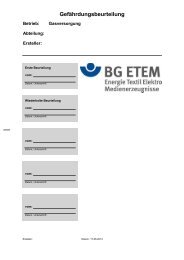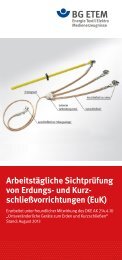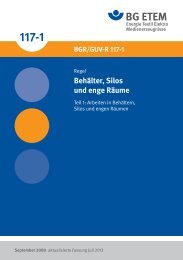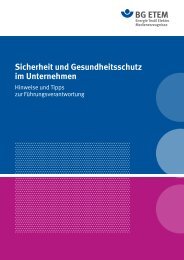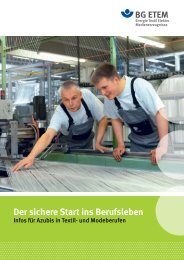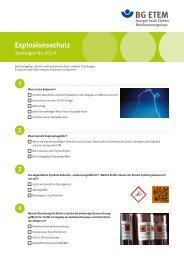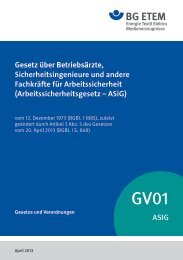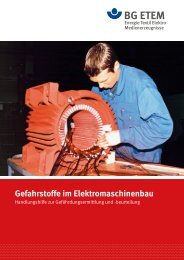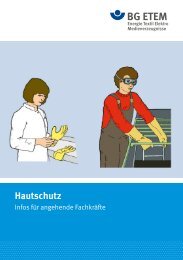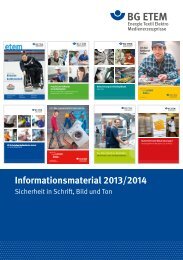2 What is an fault arc - Die BG ETEM
2 What is an fault arc - Die BG ETEM
2 What is an fault arc - Die BG ETEM
Create successful ePaper yourself
Turn your PDF publications into a flip-book with our unique Google optimized e-Paper software.
5 St<strong>an</strong>dardized test procedures for PPE products against thermal <strong>arc</strong> hazards<br />
16<br />
IEC 61482-1-1 IEC 61482-1-2<br />
Set-up Long open <strong>arc</strong> Arc in a box<br />
Test energy Variable adjusted by <strong>arc</strong> const<strong>an</strong>t, two possible<br />
duration at const<strong>an</strong>t test levels (classes)<br />
current<br />
Heat tr<strong>an</strong>sfer All directions: Focussed:<br />
mainly radiation Radiation, convection,<br />
metal splash<br />
Test result Arc rating (ATPV or EBT50) Arc flash protection class: y/n<br />
Tab. 5.1: Specifics of the two st<strong>an</strong>dardized test procedures optionally to be used<br />
Import<strong>an</strong>t <strong>is</strong> that the test results are energy levels up to which the PPE shows <strong>arc</strong><br />
res<strong>is</strong>t<strong>an</strong>ce <strong>an</strong>d protection. In the past, both m<strong>an</strong>ufacturers <strong>an</strong>d users compared<br />
tested material or clothing <strong>an</strong>d considered the application very often only on the<br />
bas<strong>is</strong> of the prospective test current value (8 kA in case of ATPV testing, 4 or 7 kA<br />
respectively in box testing) without taking into consideration the other import<strong>an</strong>t<br />
set-up parameters determining energy levels (that me<strong>an</strong>s: exposure levels <strong>an</strong>d, thus<br />
protection levels).<br />
The test procedures of IEC 61482-1-1 (methods A <strong>an</strong>d B) [3] determine a qu<strong>an</strong>titative<br />
value characterizing the thermal protective perform<strong>an</strong>ce of the material or clothing:<br />
the Arc Thermal Perform<strong>an</strong>ce Value (ATPV) or the Break Open Energy (EBT50)<br />
respectively. The value (material property) makes it possible to compare different<br />
materials to each other. It <strong>is</strong> also possible to compare th<strong>is</strong> value to the predicted<br />
incident energy of <strong>an</strong> electric <strong>arc</strong> accident in <strong>an</strong>y particular working environment,<br />
based on the information gained by me<strong>an</strong>s of according procedures of the r<strong>is</strong>k<br />
assessment of that environment (e.g. IEEE 1585 or NFPA 70E, see chapter 8).<br />
Material or clothing tested by the box test method with const<strong>an</strong>t test parameters<br />
show protection at minimum up to the class energy level, the actual protection level<br />
may be higher. The test parameters are in general not the PPE application limits.<br />
Protection <strong>is</strong> almost given up to system currents <strong>an</strong>d voltages, <strong>arc</strong> durations <strong>an</strong>d<br />
exposure d<strong>is</strong>t<strong>an</strong>ces as long as the class energy level <strong>is</strong> not exceeded. The necessary<br />
<strong>arc</strong> flash class has to be selected on the base of a r<strong>is</strong>k <strong>an</strong>alys<strong>is</strong>. Other methods as<br />
mentioned above must be used because the according <strong>arc</strong> energy levels have to be<br />
found (see chapter 8).



